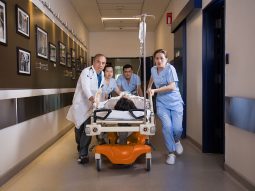Thanh Jean Pierre, a 22-year-old French overseas Vietnamese, experienced a motorcycle accident in Binh Duong that resulted in a fractured jaw and eye socket. He underwent successful treatment at FV Hospital after a complex surgical procedure. Fortunately, he had purchased travel insurance for his trip, which covered all medical expenses.
Mr Thanh and his French girlfriend were visiting Vietnam to explore his homeland. On the morning of July 21st, while riding on a road in Binh Duong, Thanh tried to avoid a pothole but collided head-on with a vehicle coming from the opposite direction at high speed, causing him to lose consciousness. He was rushed to an emergency room at a private hospital in Thu Duc.
Due to the severity and complexity of his injuries, he was recommended to be transferred to a hospital with more advanced medical facilities for treatment. After careful consideration, his family decided to move him to FV Hospital, where he could receive care equivalent to the quality of hospitals in France and his medical expenses would be covered through his international travel insurance package.
Fractured upper jaw, lower jaw, and eye socket
Nguyen Thanh Tung, MD, PhD, Head of the Oral & Maxillofacial Surgery-Dental Surgery Department at FV Hospital, stated that the patient had suffered severe facial injuries. Three-dimensional X-ray images taken by the Planmeca Viso G7 machine clearly showed fractures on the outer and lower edges of the left eye socket, fractures on both sides of the upper jaw, fractures on the prominent part of the right lower neck, and a fractured angle of the left lower jaw with an impacted wisdom tooth lying horizontally right above the fracture line. Fortunately, his brain had not been affected by his injuries.

“Due to the impact from the left side, the patient’s entire upper jawbone was displaced to the right, accompanied by multiple fractures in the lower jaw, causing the patient’s jaw to be misaligned. It was impossible for him to close his mouth, or chew,” says Dr Tung.
Specialists in oral and maxillofacial-dental surgery, cosmetics and plastic surgery, otorhinolaryngology, and dietetics and nutrition collaborated to develop an optimal treatment plan that would not only restore the patient’s functionality but also ensure a good aesthetic outcome.
Upon admission to the hospital, the patient experienced nosebleeds which the otorhinolaryngology team monitored closely.

The Oral & Maxillofacial Surgery—Dental Surgery team, led by Dr Tung, performed surgery to correction the patient’s jaw. Dr Tung performed the jawbone realignment and used plate screws to fix the bones in the left outer and lower eye socket area, the upper jawbone on both sides (nasal pillar and cheekbone area), the right convex jawbone, and the left jaw angle with the removal of the wisdom tooth.
Dr Tung explains that surgical process required a high degree of precision, and 3D X-ray images provided significant support for the surgical procedure as the details of the injuries were clearly visible. It is worth noting that the Planmeca Viso G7 is the most advanced Conebeam CT (CBCT) X-ray machine for maxillofacial surgery in Vietnam at present.
Doctors use braces and fasten 40 screws in the patient’s facial area.
Dr Tung explained that due to the deviation of the entire upper jaw to the right, he had to readjust the position of the jawbone and use nine braces and 40 screws to connect Thanh’s maxillofacial bones. Additionally, he used screws to stabilise both jaws to ensure a stable bite joint after surgery and to aid the patient’s jaw movement. It is expected that six months post-surgery, Thanhs’ healing progress will be evaluated, and a plan will be made to remove the braces and screws.
“Fixing the jaws after surgery prevented the patient from opening their mouth, making it challenging to eat and chew as they recover after the operation. However, thanks to the advice from the specialised doctors of Dietetics & Nutrition Department, the patient quickly recovered after the surgery,” explains Dr Tung.
“After surgery on both jaws, the bones will usually take seven to 10 days to stabilise, after which time elastic bands will be placed to help the patient practice opening their mouth. Once the jaw motility has improved and the patient’s bite is stable, the fixed screws will be removed. The time and practice of when the jaws can be unfixed varies depending on each patient’s response after the surgery and typically ranges from one to two weeks.”
The patient was fully covered by his insurance, with all medical expenses paid for.
Mr Thanh shared that at the time of purchasing his plane ticket, he was introduced to a travel insurance package for his stay in Vietnam at a cost of 40 Euros, so he decided to buy it. Little did he know that this small fee would help him overcome an unexpected accident: he was fully covered, with insurance paying 100 per cent of his medical expenses, totaling over hundreds of millions of Vietnam dong.
The process of insurance payment was implemented in its entirety by FV Hospital staff. Leveraging its status as an international hospital, FV Hospital collaborates with numerous insurance companies both locally and internationally, providing direct payment services. Therefore, patients do not have to spend time dealing with insurance companies directly.

“When I was admitted to the hospital, I was very concerned about the function of my jaw and appearance due to the severity of my facial injuries. Fortunately, after the surgery, I didn’t experience much pain, just some discomfort from a few screws impacting my skin,” says patient Thanh. He was also impressed with the attentive, supportive care provided by the FV staff.
Dr Tung says that Thanh’s condition will gradually stabilise in one to two weeks. After six months, he can decide to continue treatment with a maxillofacial surgeon in France. The hospital will send electronic medical records, medical reports, and post-operative care instructions to facilitate the continuity of care by doctors in France.

 Vi
Vi 












